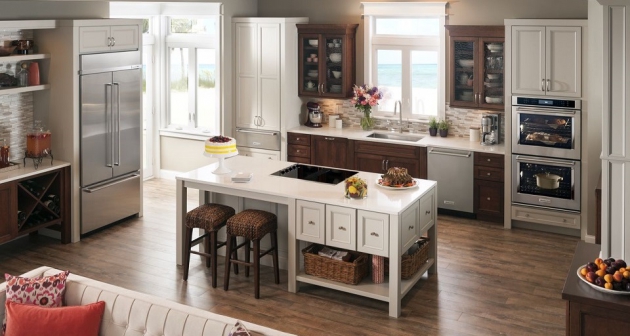Modern appliances are at the heart of the kitchen and they have a huge effect on how we live our lives. There are many makes and models of every appliance type, but they need to be placed in a location that can accommodate them. When you design a new kitchen, the appliances may be the last thing on your mind. This is a mistake, it’s important to make the layout of the kitchen around your new or existing appliances. An appliance specialist can help you if they are involved at an early stage. If you’re determined to go it alone, here are three appliance types and sizes to consider.
1. Refrigerators
Modern refrigerators may have a host of useful features including door-in-door access, built-in thermometers, digital cameras and more. But, they are complex and they are available in a wide variety of styles and sizes. The more common widths are: 36”, 42” and 48”. Some suburban kitchens have narrower 36” models and a freestanding refrigerator needs a 72” tall opening for installation. If the refrigerator is built-in, the space requirements increase to an 84” tall opening. Refrigerators and freezers may be separate purchases which come in a broader size range, the widths, are: 10”, 24”, 30” and 36·. A popular combination is a 36” wide refrigerator next to a 24” wide freezer. There are also wine column refrigerators that come in 18” and 24” widths.
2. Dishwashers
The width of a standard dishwasher is 24”, but larger homes may have a second machine for extra convenience and flexibility. This is especially true if people want to avoid an extra trip to the kitchen from a pool or bar area. In this case, an additional slimline dishwasher with a width of 18” or a dishwasher drawer may be the solution. Most full-size dishwashers have a height of 35”, but ADA models are 34” high and they can be raised or lowered to fit easily under the countertops. A key factor with dishwashers is the depth which must be carefully considered to accommodate the hoses. Most European made models have flush fit because the sleek style is an essential aspect of their design. Most American made models protrude slightly from the cabinets if the dimensions are not factored into the kitchen design. Another option is a panel that blends the dishwasher into the cabinetry and the maximum depth for this is 23⅙”. When a standard dishwasher door is fully open it will extend 27” into the kitchen and this is important if you want to avoid blocking foot traffic.
3. A Washer and Dryer
Both washers and dryers come in a wide variety of sizes to accommodate homes with different needs. A 24” wide washer is considered to be a compact model and these are an ideal fit for smaller apartments. They are flexible, they require no venting and they can be installed under the kitchen counter, in a closet, a bathroom or behind a mudroom cabinet. The 27” wide front load washers are considered to be standard size and they are typically mounted on a pedestal draw for extra storage and easier use. The larger washers have a width of 30” and there are fewer models at this price point. These washers are harder to install and they are overkill unless you have a very large family or you like to wash rugs.
In Conclusion
Taking extra care and measuring twice is the key to success if you’re in the market for new appliances. Even if you have the available space, make sure that they will fit through the principal entryway and other points that need to be negotiated to install the appliance.
If you’re searching for new appliances, you can explore your options with our online collections or further guidance and help, speak to a home appliance specialist.

